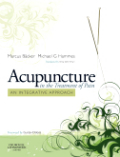
Acupuncture in the treatment of pain: an integrative approach
Backer, Marcus
Hammes, Michael G.
The book delineates the potentials and limits of acupuncture in the treatmentof pain in the context of a modern bio-psycho-social concept of pain therapy.This is realized by an integration of western and traditional Chinese medicine, with the aim to meet the respective other medicine system on the one hand and critical distance on the other. The book consists of two parts. The first part (chapter 2-8) gives the background for both traditional Chinese concepts to pathogenesis, diagnosis and treatment of pain and basics of the conventional, western approach to pain treatment. The second part (chapter 9-17) gives detailed information for the integrative treatment of all common painful conditions. For every single indication conventional and traditional Chinese treatmentoptions (including Chinese phytotherapy) are shown and the value of acupuncture, scientific data about its efficacy and its possible mode of action (in western-physiological terms) are discussed. INDICE: PART I: Basics of Western und Traditional Chinese Approach to PainTherapy1 Introduction2 Pain from the western perspective2.1 Basics and background (bio-psycho-social concept of chronic pain) 2.2 Diagnosis 2.3 Treatment guidelines 2.4 Conventional treatment modalities in pain therapy 2.5 Western naturopathic treatment modalities in pain therapy3 Pain from the traditional Chinese perspective 3.1 Basics of traditional Chinese medicine theory 3.2 Concepts for the pathogenesis of pain 3.3 Bi-Syndrome 3.4 Prevention4 Diagnosis in TCM 4.1 Comparison of the perspectives in East and West 4.2 Anamnesis 4.3 Special aspects of physical examination (Tongue and Pulse Diagnosis) 4.4 Differentiation of the syndrome pattern 4.5 Correlation between western diagnosis and traditional Chinese syndrome patterns 4.6 Relevance of syndrome diagnosis for clinical practice5 Guidelines for the treatment of pain in TCM 5.1 Formulation ofthe therapeutic principle 5.2 Therapeutic strategies6 Acupuncture 6.1 Definition 6.2 Neurobiological mechanisms of acupuncture in the treatment of pain 6.3Indications 6.4 Contraindications 6.5 Side effects 6.6 Technique and practical performance 6.7 Treatment principles 6.8 Moxibustion6.9 Related Techniques (Dry needling, EA, Ear Acupuncture, Scalp A., Laser, TENS, Neuraltherapy)7 Channels and important acupoints 7.1 Channels and points 7.2 Acupoints and channels from a western perspective8 Further treatment modalities in TCM 8.1 Traditional Chinese Phytotherapy 8.2 TCM Dietetics 8.3 Tuina 8.4 Gua Sha 8.5 Qi GongPART II: Treatment of painful conditions9 Head- and facial pain 9.1 General guidelines 9.2 Migraine 9.3 Tension type headache 9.4 Cervicogenic headache 9.5 Temporomandibular dysfunction 9.10 Trigeminal neuralgia 9.11 Atypical facial pain 9.12 Symptomatic facial pain (sinsusitis, dental pain, parainfectious headache)10 Pain in the locomotor system 10.1 General guidelines 10.2 Cervicocephal Syndrome 10.3 Neck pain10.4 Shoulder pain (Bursitis subacromialis, Tendinitis calcarea, Impingement S.)10.5 Epicondylitis humeroradialis10.6 Tendovagintis and Tendinopathies10.10 Spondylogenic thoracical pain10.11 Chronic low back pain10.12 Ischialgia10.13 Failed back surgery Syndrome10.14 Piriformis Syndrome10.15 Osteoarthritis of knee and hip10.16 Achillodynia10.17 Osteoporosis10.18 Rheumatoid Arthritis11 Fibromyalgia12 Visceral pain 12.1 General guidelines 12.2Angina pectoris 12.3 Thoracic pain of non-cardiac origign 12.4 Gastritis 12.5Functional dyspepsia 12.6 Irritable bowel Syndrome 12.7 Chronic pelvic pain13Neuropathic pain 13.1 General guidelines 13.2 Carpal tunnel Syndrome 13.3 Meralgia paresthetica 13.4 (Post)herpetic pain 13.5 Polyneuropathy 13.6 Complex regional pain Syndrome (CRPS) 13.7 Central pain (post-stroke pain, paraplegia) 13.8 Phantom-limb pain14 Vascular pain 14.1 General guidelines 14.2 Raynaud Syndrome 14.3 Peripheral arterial occlusive disease15 Acupuncture in palliative care 15.1 Introduction 15.2 Definitions 15.3 Clinical aspects 15.4 Summary16 Psycho-vegetative disorders 16.1 General guidelines 16.2 Burn out/ exhaustion/ muscular weakness 16.3 Weakness of the immune system (Recurrent infections) 16.4 Insomnia 16.5 Increased Irritability 16.6 Unspecific vertigo 16.7 Tinnitus 16.8 Depression 16.9 Neuropsychological deficits17 Psychosomatic aspects in pain therapy18 The Future
- ISBN: 978-0-443-06869-0
- Editorial: Churchill Livingstone
- Encuadernacion: Cartoné
- Páginas: 560
- Fecha Publicación: 20/02/2010
- Nº Volúmenes: 1
- Idioma: Inglés
